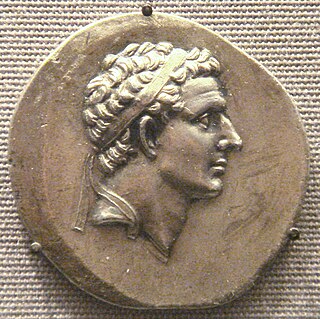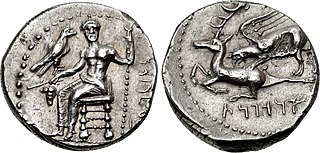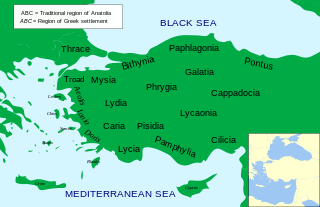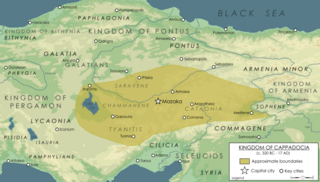Related Research Articles
This article concerns the period 159 BC – 150 BC.
Year 130 BC was a year of the pre-Julian Roman calendar. At the time it was known as the Year of the Consulship of Lentulus/Pulcher and Perperna and the Fifth Year of Yuanguang. The denomination 130 BC for this year has been used since the early medieval period, when the Anno Domini calendar era became the prevalent method in Europe for naming years.
Year 157 BC was a year of the pre-Julian Roman calendar. At the time it was known as the Year of the Consulship of Caesar and Orestes and the Seventh Year of Houyuan. The denomination 157 BC for this year has been used since the early medieval period, when the Anno Domini calendar era became the prevalent method in Europe for naming years.

Demetrius I, surnamed Soter, reigned as king (basileus) of the Hellenistic Seleucid Empire from November 162 to June 150 BC. Demetrius grew up in Rome as a hostage, but returned to Greek Syria and overthrew his young cousin Antiochus V Eupator and regent Lysias. Demetrius took control during a turbulent time of the Empire, and spent much of his time fighting off revolts and challenges to his power from threats such as Timarchus and Alexander Balas.

Attalus II Philadelphus was a ruler of the Attalid kingdom of Pergamon and the founder of the city of Attalia (Antalya).

Pharnaces I, fifth king of Pontus, was of Persian and Greek ancestry. He was the son of King Mithridates III of Pontus and his wife Laodice, whom he succeeded on the throne. Pharnaces had two siblings: a brother called Mithridates IV of Pontus and a sister called Laodice who both succeeded Pharnaces. He was born and raised in the Kingdom of Pontus.

Ariarathes V Eusebes Philopator was a son of the preceding king Ariarathes IV of Cappadocia and queen Antiochis. He was distinguished by his contemporaries for the excellence of his character and his cultivation of philosophy and the liberal arts and is considered by some historians to have been the greatest of the kings of Cappadocia.

Orophernes Nicephorus was one of the two sons Antiochis pretended to have had with Ariarathes IV, the king of Cappadocia because she failed to have children. However, she then did bear a child, Mithridates, and told her husband about the fake sons. These were sent to Rome and Ionia respectively to avoid a succession dispute with the legitimate son, whose name was changed to Ariarathes and who succeeded his father as Ariarathes V in 163 BC. A few years later Orophernes deposed him with the help of Demetrius I Soter, who became the king of the Syria-based Seleucid Empire in 161 BC when he overthrew Antiochus V, an underage king, and his regent, Lysias. The reign of Orophernes was short-lived. The Romans restored Ariarathes V.

Ariarathes IV, surnamed Eusebes, "the Pious",, was the king of Cappadocia in 220–163 BC.

Ariarathes III, son of Ariaramnes, ruler of Cappadocia, and grandson of Ariarathes II, married Stratonice, a daughter of Antiochus II, king of the Seleucid Empire and wife Laodice I, and obtained a share in the government during the lifetime of his father. About 250 BC he was the first ruler of Cappadocia to proclaim himself king (basileus). It is known that he sided with Antiochus Hierax in his war against Seleucus II Callinicus. Ariarathes is also said to have expanded his kingdom adding Cataonia to his dominions. By his marriage he was the father of Ariarathes IV.

Ariaramnes, was the Ariarathid king of Cappadocia from 280 BC to 230 BC. He was the son and successor of Ariarathes II.

Ariarathes II, satrap and king of Cappadocia, son of Holophernes, fled into Armenia after the death of his uncle and adopted father Ariarathes I, ruler of Cappadocia. After the death of Eumenes he recovered Cappadocia with the assistance of Ardoates, the Armenian king, and killed Amyntas, the Macedonian satrap, in 301 BC, but was forced to accept Seleucid suzerainty. He was succeeded by Ariaramnes, the eldest of his three sons.

Ariarathes I was the last Achaemenid Persian governor (satrap) of the province (satrapy) of Northern Cappadocia, serving from the 340s BC to 331 BC. He led defensive efforts against the Macedonian invasion, commanded by Alexander the Great, and later fought at the Battle of Gaugamela under Darius III, the last King of Kings of the Achaemenid Empire. After the fall of the Achaemenid Empire, Ariarathes continued his resistance against the Macedonians, ruling concomitantly as an Achaemenid remnant and a precursor to the Kingdom of Cappadocia. He is regarded as the founder of the Iranian Ariarathid dynasty.
Nicomedes III Euergetes was the king of Bithynia, from c. 127 BC to c. 94 BC. He was the son and successor of Nicomedes II of Bithynia.

Cappadocia was a province of the Roman Empire in Anatolia, with its capital at Caesarea. It was established in 17 AD by the Emperor Tiberius, following the death of Cappadocia's last king, Archelaus.
Stratonice was a princess of Cappadocia and through marriage a queen of Pergamon.

Laodice V was a Seleucid princess. Through marriage to Perseus king of Macedon she was a Queen of the ruling Antigonid dynasty in Macedonia and possibly later of the Seleucid dynasty.

Classical Anatolia is Anatolia during Classical Antiquity. Early in that period, Anatolia was divided into several Iron Age kingdoms, most notably Lydia in the west, Phrygia in the center and Urartu in the east. Anatolia fell under Achaemenid Persian rule c. 550 BC. In the aftermath of the Greco-Persian Wars, all of Anatolia remained under Persian control except for the Aegean coast, which was incorporated in the Delian League in the 470s BC. Alexander the Great finally wrested control of the whole region from Persia in the 330s BC. After Alexander's death, his conquests were split amongst several of his trusted generals, but were under constant threat of invasion from both the Gauls and other powerful rulers in Pergamon, Pontus, and Egypt.
Antiochis was a Hellenistic princess from the dynasty of the Seleucids and in the first half of the second century BC queen of Cappadocia.

Cappadocia was a Hellenistic-era Iranian kingdom centered in the historical region of Cappadocia in Asia Minor. It developed from the former Achaemenid satrapy of Cappadocia, and it was founded by its last satrap, Ariarathes. Throughout its history, it was ruled by three families in succession; the House of Ariarathes (331–96 BC), the House of Ariobarzanes (96–36 BC), and lastly that of Archelaus (36 BC–17 AD). In 17 AD, following the death of Archelaus, during the reign of Roman emperor Tiberius (14–37 AD), the kingdom was incorporated as a Roman province.